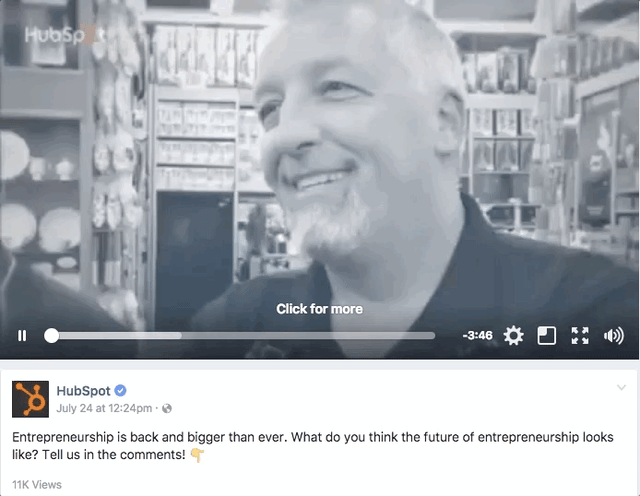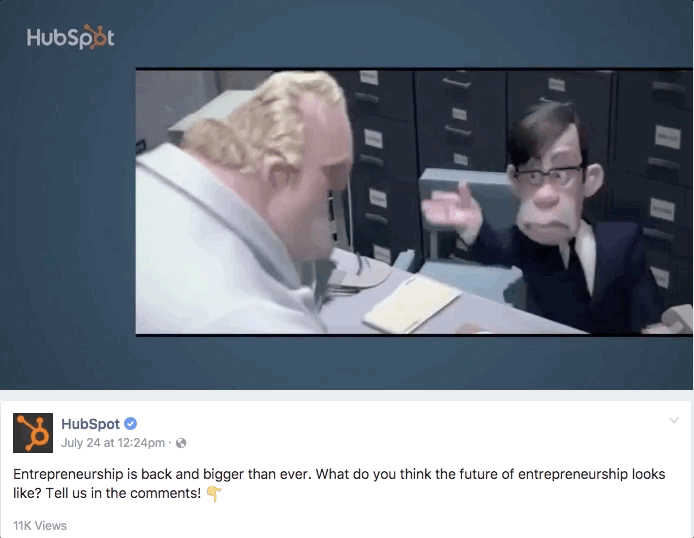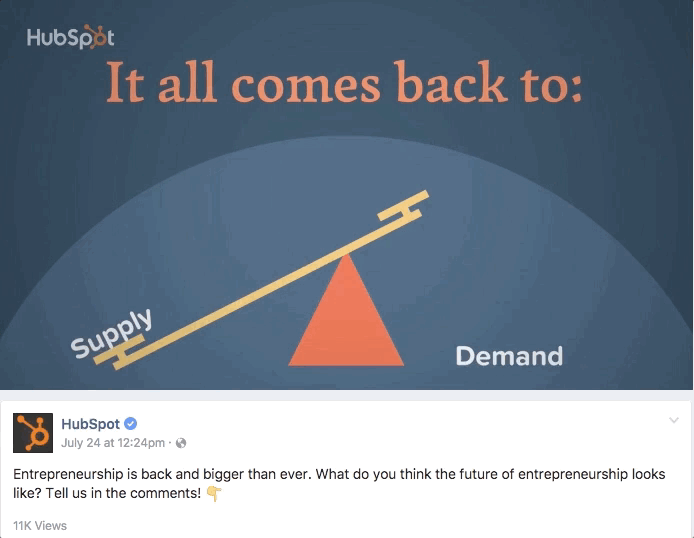At HubSpot, our one-minute Facebook videos usually receive more views than our longer videos. So how is it that our third most viewed video right now is almost four minutes long?
Facebook will boost a video’s organic reach if it deeply engages viewers, so we knew our video needed to grip our audience from start to finish -- especially since it’s four times longer than the majority of our videos. If it didn’t captivate them, Facebook could squash the video’s organic distribution.
To maximize audience engagement, we implemented psychology-backed hacks throughout the entire video. Let’s check it out and the takeaways below to learn how to fully capture an audience’s attention.
6 Psychology-based Hacks for Making Engaging Videos
1) Spark Curiosity
To spark on-demand curiosity, George Loewenstein, Professor at Carnegie Mellon University, recommends leveraging the information gap theory of curiosity.
The theory states that sensing a knowledge gap between what you know and what you want to know compels you to take action to fill it, like clicking through to a story.
We evoked curiosity in our viewers by using a simple, yet thought-provoking headline: Entrepreneurship is Back.
This title can trigger loads of questions from our audience, like “Entrepreneurship was gone?”, “What does it look like now?” and “How can I be an entrepreneur in today’s age?”, increasing the odds that they would click on our video.
By stimulating curiosity and leaving questions unanswered, we could succesfully create a gap between what the reader knows and what they want to learn.
2) Hook Your Audience
When Facebook analyzed their users’ video consumption data in 2016, they discovered that 45% of people who watch the first three seconds of a video will keep watching it for at least 30 seconds.
This helped us realize that sparking our audience’s curiosity wasn’t enough to engage them. We needed to instantly hook our viewers in the first three seconds. The human attention span isn’t long enough to be entertained by sluggish content.
What hooks people, though? According to Buffer, an effective video hook visually engages viewers and previews the video’s core message. Hooks are potent because they can simultaneously grab your viewers’ attention and generate interest in the rest of the video.
During our video’s first three seconds, we rapidly cut between numerous Shark Tank pitches. The swift frames caught our viewers’ eye. And if they recognized the entrepreneurs, they knew exactly what the video was about.

The narrator quickly summarizes the video’s main point too. He cuts right to the chase, informing the viewer that the video covers the rise of entrepreneurship. Many of our viewers dream about starting their own business, so this quick sketch of the topic definitely piqued their interest.
3) Make It Visual
When we were babies, we relied on vision to associate objects with behaviors, like a ball meaning play time. Vision was the only way to learn about the world.
That’s why you can understand visual information in 250 milliseconds (almost two times faster than a blink of an eye) and why your visual system activates over 50% of your brain. Watching something has always been the best way to learn.
Since visual storytelling helps people grasp concepts and data easily, we decided to complement our video’s text and narration with dynamic graphics, popular movie scenes, and footage of real people.
Each time our narrator expanded on a concept or some data, our viewers could listen to the information and watch a visual representation of it. This helped them form a concrete understanding of the video’s central idea.

4) Tell a Story
When someone tells you a story, they can plant their personal experiences and ideas directly into your mind. You start to feel what they feel.
Powerful stories evoke empathy because they activate parts of the brain that’d operate if you actually experienced the stories’ events. If someone describes eating a plate of lobster mac and cheese, your sensory cortex lights up. If someone recounts scoring their first touchdown, your motor cortex enlivens.
By using our memories to recreate the story’s sensory details, we turn its events into our own idea and experience.
Our video told a story about entrepreneurship. More specifically, entrepreneurship’s history, its economic benefits, and the reasons for its recent rocky past, current resurgence, and hopeful future.
By weaving these facts into a narrative, our viewers could place themselves into the modern entrepreneur’s mind. This allowed them to relate to the lack of fulfillment the “work to live” mentality provides and the impact their potential entrepreneurial pursuits could have on themselves and the world.
5) Inspire Your Audience
According to Psychology Today, brand preference is largely an emotional decision. Humans associate the same personality traits to brands as they do with people.
Choosing your favorite brand is like choosing your best friend, and since we spend time with the people who make us feel good, we engage with the brands that also make us feel good.
If you want your videos to resonate with your viewers, then they need to kindle warm feelings. In fact, happiness, hope, and excitement are some of the most common emotions that drive viral content.
By highlighting the digital age’s low market entry costs, a diminished need for investors, and the ability to efficiently build unprecedented amounts of brand engagement through social media, our video inspired entrepreneurs everywhere to keep pursuing their dreams because their futures look brighter than ever.
6) Make it Credible
Trust is pivotal in the inbound marketing world. If our viewers didn’t trust us, they would never consume our video content. And just because we stamped the HubSpot brand on the video doesn’t automatically validate its points.
That’s why we featured clips of Jack Delosa, Founder and CEO of The Entourage, backing up our points about finding a problem before you provide a solution, the purpose behind starting a business, and the power of social media.

He’s an established entrepreneur and an outside source, so his backing helps bolster our video’s credibility and, in turn, our audience’s trust in our content.
On Facebook, video isn’t king. Engaging video is king. And to create gripping videos, you need to be able to understand and predict human preference and behavior.
Nowadays, psychology isn't just a college prerequisite anymore. It's the core of marketing.
from Marketing https://blog.hubspot.com/marketing/psychology-hacks-for-making-engaging-videos



No comments:
Post a Comment